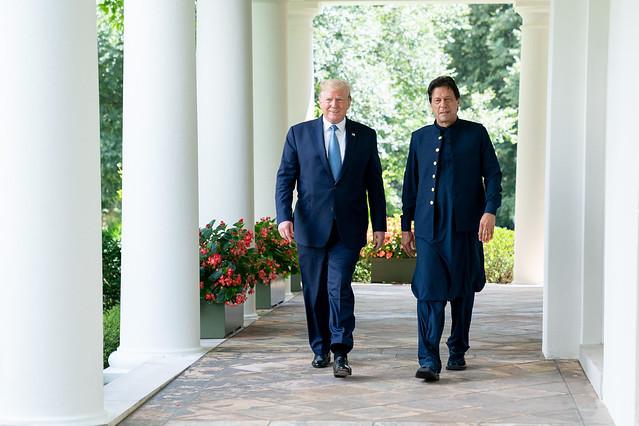
Pakistan Prime Minister Imran Khan’s recently concluded three-day visit to Washington was aimed at resetting US–Pakistan relations. The relationship has been under great strain for several years and reached its nadir after the assumption of office by Donald Trump in 2017. Trump has more than once during the past couple of years signalled his immense displeasure with Pakistan’s support for the Taliban, who have been fighting the US-backed Kabul government’s forces, carrying out terrorist attacks, and targeting American troop concentrations.
The existence of safe havens in Pakistan used by the Taliban, and other terrorist groups such as the Haqqani network, to attack American targets provided sufficient evidence for the Trump administration to suspend US$1.3 billion of military aid and put on hold US$800 million of economic aid to Pakistan. In January 2018, Trump castigated Pakistan in no uncertain terms: ‘The United States has foolishly given Pakistan more than 33 billion dollars in aid over the last 15 years, and they have given us nothing but lies and deceit, thinking of our leaders as fools. They give safe haven to the terrorists we hunt in Afghanistan … No more!”
Initially, Pakistan responded to such charges with defiance and turned to China and Saudi Arabia for financial support. That attitude reflected the two countries’ very different goals regarding Afghanistan. The Pakistani stance was summed up succinctly as far back as 2007 by the then army chief, General Kayani. ‘How long are you staying this time?’ he asked US ambassador Ryan Crocker. ‘Because you come and you go … If you think we are going to turn the Taliban and Haqqanis and others into mortal enemies of ours and watch you walk out the door, you are completely crazy. Are we hedging our bets? You bet we are.’
However, calculations on both sides have undergone significant changes in the past year. Pakistan is in deep financial crisis and is virtually bankrupt. Foreign exchange reserves are down to barely two months of imports—and that’s only thanks to a US$1 billion emergency loan from China. Ironically, the unsustainable level of imports has been the result of Islamabad’s commitment to China’s Belt and Road Initiative, of which the China–Pakistan economic corridor is a major part.
Pakistan has been forced to accept a US$6 billion bailout from the International Monetary Fund to temporarily alleviate its dire economic situation. IMF loans come with conditions that Pakistan may find difficult to meet. Furthermore, Pakistan requires US support to continue to receive international financing, given Washington’s voting clout in both the IMF and the World Bank. Islamabad therefore needs to be on good terms with the US in order to keep itself financially afloat.
The US, for its part, needs Pakistan in order to extricate itself from the Afghanistan imbroglio. The American military intervention in Afghanistan has been going on for 18 years and can be brought to an end only if the Afghan government and the Taliban reach an agreement that allows the US to withdraw its forces without a loss of face. The US special envoy, Zalmay Khalilzad, has been busy negotiating with the Taliban for a year to arrange for a withdrawal that doesn’t look like a defeat.
The US needs Pakistan to act as a facilitator in this process because of Islamabad’s leverage with the Taliban. It also needs Pakistan to persuade the Taliban to negotiate with the Kabul government for a future dispensation in Afghanistan that the US can live with. Pakistan has been willing to assist, but the Taliban’s recalcitrance and opaque decision-making process, as well as Islamabad’s own interest in preserving the Taliban as a strategic asset for future use, have caused the negotiations to be excruciatingly slow.
Trump made it clear during Khan’s visit that his administration depends on Pakistan to help get the US out of Afghanistan without losing credibility. Khan has signalled that his government is willing to do so but has at the same time warned the US not to ‘expect this to be easy, because it is a very complicated situation’. In some ways this is a realistic assessment of the situation in Afghanistan—in addition to Pakistan and the US, several major foreign powers (Iran, Russia, and India, in particular) are actively involved and have interests that diverge fundamentally from those of Washington and Islamabad.
It’s also Khan’s signal to Washington that Pakistan will be willing to help the US extricate itself from Afghanistan if the price is right both economically and in strategic terms. The terms would include resumption of US military and economic aid frozen by the Trump administration as well as US pressure on Kabul and New Delhi to recognise Pakistan’s strategic and political interests both in Afghanistan and in relation to Kashmir.
Trump’s statement that he was willing to mediate between India and Pakistan on Kashmir should be seen in this context. It wasn’t simply a gaffe emanating out of his ignorance of the Indian position that rejects any third-party interference in the Kashmir dispute. It was also a signal to Pakistan that Washington is willing to face Indian ire in order to placate Islamabad.
It’s too early to say whether this exchange of economic and political favours between Washington and Islamabad will lead to a resetting of relations. However, both sides seem to hope that that will be the case.